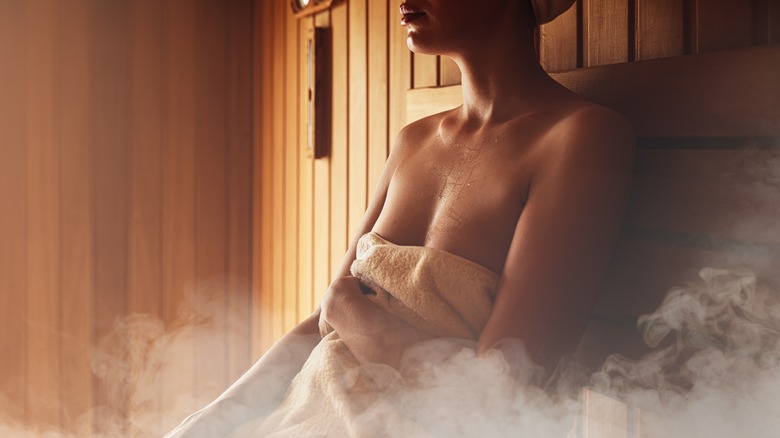We Tried This Steamy Shower Trick To Soothe A Sore Throat And Here's What Happened
Growing up in an Asian household, anything steam-related to soothe sore throats and coughs was a go-to. Home remedies you should try for congestion were aplenty. Even as I pen this, I can picture my mother with a bowl of steaming hot water and a towel over her shoulder beckoning me to come and inhale the steam as I hacked away with a stubborn cough.
Cut to adult life, and the internet is full of recommendations about how steam showers can do all sorts of things for you. Sore throats and congestion aside, apparently they can boost circulation, lower your blood pressure, relieve muscle and joint stiffness, and even improve your skin health by opening up your pores. I must admit, the thought of stepping into a shower full of hot water-induced steam was a little different from inhaling vapor over the sink or a basin of water but I thought I'd give it a go, mainly because I felt a sore throat coming on and my muscles were particularly sore after a workout.
Turns out, there's truth to the claims. My sore throat seemed to disappear, although I'm not sure if there was a common cold or allergy on the horizon with this particular discomfort. It could have just been a mild throat tickle that was going to go off in a day or two anyway. Here's what I did.
How to do the steamy shower hack
YouTube is full of ideas on how to make your steam showers more exquisite like adding eucalyptus oil to the walls of the shower cubicle and even investing in a brand-new steam shower kit. But I chose to do it the old-fashioned way — draw the shower curtains tight around the tub, seal up the added space above with a large towel or two, and turn the hot water on — full blast — for about 20-30 minutes. For added steam in the bathroom, I turned on the sink tap too. Then I closed the bathroom door and waited.
After about 20 minutes, the bathroom seemed to have filled with enough steam to fog the mirrors and coat all the beauty products in a film of warmth, so I decided to step into the tub. This part was a bit tricky with the obvious worry of the streaming hot water hitting my skin and ruining the experience. After carefully maneuvering my fingers toward the tap and switching off the water, I stood there in a cloud of comforting steam.
The instant sense of relaxation is what hit me first. There's something about warm water vapor that seems to melt your troubles away. Breathing in the steam felt good on my airways. My throat tickled a bit the more I breathed in but eventually, the sensation died down. After basking in the haze for about 10 minutes, I moved on to have a regular warm water shower.
Would we recommend the steam shower trick for sore throats?
Of course. Why not? Even if your sore throat doesn't go away, the entire experience is pretty relaxing, and feeling good mentally can go a long way when you're not feeling great physically.
I can only imagine, however, that the steaming experience would be a lot better in a bathroom that had a closed cubicle setup or better yet, a professionally installed steam shower kit. From the few times I've been inside a hotel's steam room, I can definitely say that the volume of mist from added vents that dispense the stuff is a big plus. If you don't have any of these, however, a normal shower-curtained bathing area is still good enough. Just make sure you cover as many open spaces as possible with extra towels or bedsheets. I'd also recommend leaving the hot water on full blast for as long as you can (within reasonable limits, of course).
Using steaming techniques like inhaling vapor from hot water in a basin or stepping into a steamy shower are home remedies I'd pick over medications, especially when the ailment you're trying to get rid of is something as minor as a sore throat. But there are also times when you should be concerned about your sore throat. If you have a fever that's not going away, your tonsils are swollen, and if you have other symptoms like difficulty breathing, problems swallowing, or swelling in your neck or face, you should be seeing a doctor.



